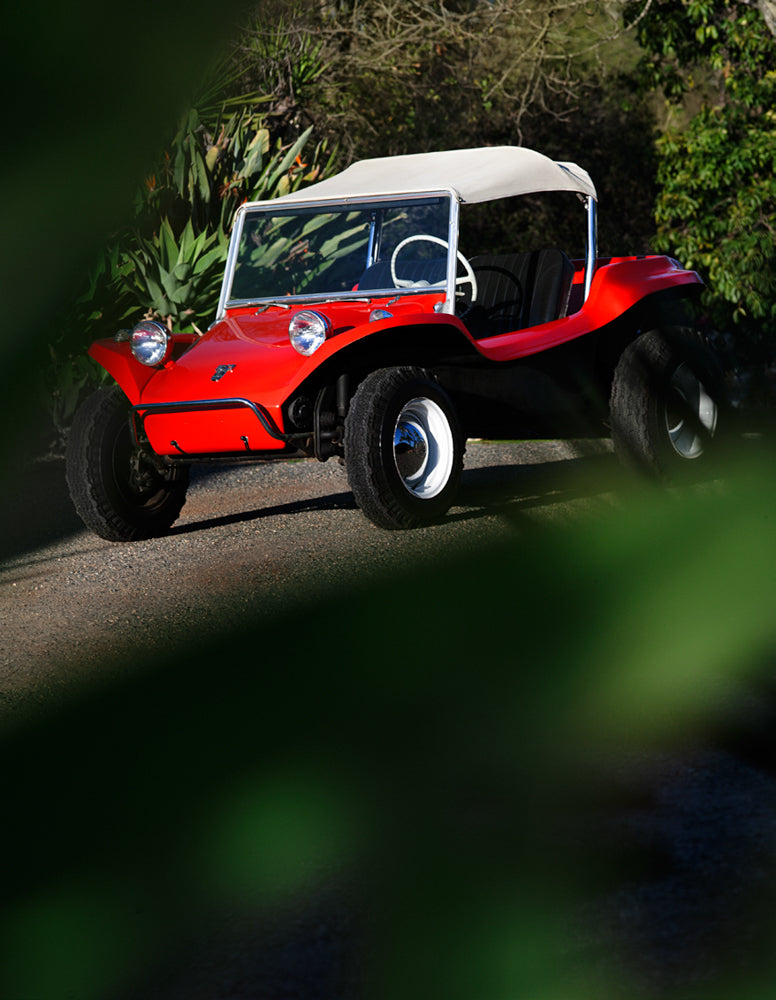
Dune Buggy Dreams
DUNE BUGGY DREAMS


In 1968’s The Thomas Crown Affair, Steve McQueen introduced the world to the Meyers Manx dune buggy by launching it over a sandy ridge, nearly blowing Faye Dunaway’s babushka clean off her head.
Bruce Meyers had designed the Manx four years earlier, but it was the King of Cool and a Hollywood film that turned the car into an icon. One-off, homebuilt beach buggies in one form or another had been appearing on California beaches since the 1950s, but they were heavy, cumbersome, and unsightly. Meyers, a SoCal native skilled in boat building and figure drawing, decided that something better, something “more beautiful” could be developed. So he set about making one single-handedly, using, in his words, “the curves of a woman’s body” as inspiration.
“My mind was full of female bottoms and fiberglass sailboats, and saturated with the freedom of a sailor in the South Seas,” he says. What instantly set Meyers’s creation apart in terms of design was its materials. Up until that point, fiberglass had really only been used in boats, in which Meyers — who survived a 1945 kamikaze attack as a serviceman aboard the USS Bunker Hill — was both trained and accustomed. Without the constraints of formal car design and with the fresh perspective of an industry outsider, he applied boat-building techniques to automotive fabrication under the name B.F. Meyers & Co.

Meyers started with a lightweight, fiberglass-molded monocoque body. This was married to a modified Volkswagen Beetle chassis, with either a four-cylinder VW engine or six-cylinder Chevy Corvair engine strategically mounted in the back, which insured that the weight would provide traction for the rear-wheel drive. The result was not only a wholly distinct vehicle that, in Meyers’s words, “resembled a Disney character,” but one that also came to define a category. “If I had been trained as a car designer there would never have been a fiberglass dune buggy,” he says.
Cartoonish, loveable, and curvy, the short-wheelbase custom vehicle was also nimble. Named after the stubby-tailed Manx cat indigenous to the Isle of Man, the moniker also echoed the internationally renowned race-winning Norton motorcycle of the same name. Once suitably branded, Meyers’s next step was to test his monster, and the timing couldn’t have been better.
In the early 1960s, Honda introduced its own off-road vehicle, the CL77 “Scrambler.” As a way of demonstrating the motocycle’s extreme capabilities to the US market, Honda had elite driver Dave Ekins race from Tijuana down the Baja California peninsula of Mexico to La Paz, a distance of roughly one thousand miles. Rugged, remote, hot, and unforgiving, almost the entire route was on dirt roads or no road at all. Ekins finished in less than forty hours and set the bar for American endurance racing.



Despite the advantage of using two wheels to conquer this hostile desert terrain, Meyers, supremely confident in his creation, challenged the record and smashed it by more than four hours. (The course and subsequent race would become the Baja 1000.) Car and Driver featured the Meyers Manx on its April 1967 cover and lauded the upstart’s achievement. The cover generated overnight acclaim, which intensified shortly thereafter with the famous scene in Thomas Crown. Like Coca-Cola or Levi’s, the brand came to define the object. Say “dune buggy” and you mean a Meyers Manx.
The Manx was not only appealing, capable, and street-legal, it was also, as a kit, affordable. Thousands of orders poured in from around the world and dozens of copycats popped up overnight. It was the embodiment of the California lifestyle — sand, sea, sun, and free livin’ — all in an open-air funmobile. Hot Rod magazine called the car “a vehicular version of Beatles music.” Nearly seven thousand Meyers kits — and many more knockoffs — were produced before B.F. Meyers & Co. shut down production in 1971. Despite years of trying, Meyers could not compete with the onslaught of cheap imitators.
Today, at a spry ninety years old, Bruce Meyers is still chasing records. In between designing and building the second generation of his dune buggy, called the Manxter, Meyers is writing his autobiography, authenticating original Manxes for collectors, and holding court at monthly Manx Club gatherings in California. For the father of the dune buggy, the sun has not yet set.




